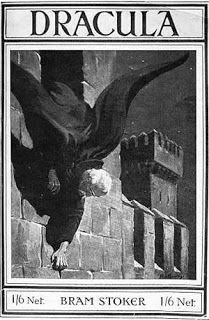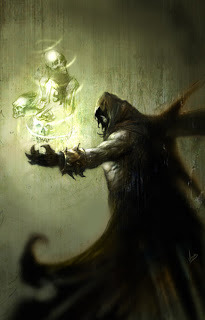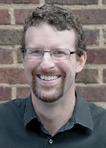FROM HOMER TO THE HOBBIT: THE HISTORY OF THE NECROMANCER
By Nancy Bilyeau
Vampire. Witch. Zombie. Werewolf. Yes, they have us surrounded.
 In films, books and TV series, it seems as if the supernatural run the show as never before. I admit to having my favorites.
In films, books and TV series, it seems as if the supernatural run the show as never before. I admit to having my favorites.
When it comes to the fanged ones, I like to get down with Dracula, whether it's in the hands of the one-and-only Bram Stoker, the gifted Elizabeth Kostova (The Historian) or the audacious Francis Ford Coppola in his adaptation (fantastic soundtrack). Anne Rice, Charlaine Harris and Justin Cronin have taken the vampire myth in fascinating directions. And, yes, I admit it: I'm a Twilight mom.
My favorite "modern" witch has to be the determined and erudite Diana Bishop in Deborah Harkness's wonderful novels, A Discovery of Magic and Shadow of Night. She's come a long way from "Double, double, toil & trouble."
As for the rest of the pack, werewolves have their place, I know, but they can't summon up the subtlety of an aristocratic vampire or a manipulative witch. Zombies? I haven't recovered from watching Night of the Living Dead in a college sorority house. I prefer my zombies Shaun of the Dead-style, thank you very much. :)
So perhaps the modern viewer could be forgiven some cynicism when faced with the latest variety of scary being in The Hobbit: The Unexpected Journey: the necromancer. And what do we have here? Well, something scary for one. The character of The Necromancer takes up very little screen time (especially considering that the movie is a darn 169 minutes long), but it is used to effect. If you don't believe me, check it out for yourself:
http://www.youtube.com/watch?v=vBZDFV-VUVQ
Now you see what I mean.
Long ago, I had decided that in my second novel, The Chalice, which revolves around a dangerous prophecy, my protagonist, Joanna Stafford, would come face to face with a necromancer, a person who purports to see into the future using the "dark arts." I plunged into historical research, not knowing what to expect. I was aware of the basic job description of the necromancer: i.e., someone who has special contact with the dead.

The image flitting through popular culture is that of a mysterious yet charismatic spell caster, as in Dungeons and Dragons.
Yet in doing my research, I was shocked to learn that necromancy dates back to antiquity. And just as storytelling that features supernatural creatures such as the vampire tells us something about human fear of aging and sexuality, belief in the necromancer, which shows up in many centuries and many cultures, reveals something of our society's feelings about death and the unknowable future.
The first written references to them were in the 5th century BCE. In ancient Greece necromancers were "evocators of souls," sorcerers who claimed to know how to summon up the spirit of a dead person and, once contacted, glimpse the future. Only they could dissolve the barrier between the living and the dead. Such skills required extensive training; the ceremonies involved drawing circles in the ground, pronouncing incantations, and using such apparatus as water, candles, scepters, swords and wands. Animal sacrifice often played a part in compelling the dead to appear.
In Homer's Odysssey, Book Eleven, Ulysses summons the spirits of dead heroes using the rituals taught him by Circe, knowledgeable of necromantic rites, to learn his fate:
Vampire. Witch. Zombie. Werewolf. Yes, they have us surrounded.
 In films, books and TV series, it seems as if the supernatural run the show as never before. I admit to having my favorites.
In films, books and TV series, it seems as if the supernatural run the show as never before. I admit to having my favorites.When it comes to the fanged ones, I like to get down with Dracula, whether it's in the hands of the one-and-only Bram Stoker, the gifted Elizabeth Kostova (The Historian) or the audacious Francis Ford Coppola in his adaptation (fantastic soundtrack). Anne Rice, Charlaine Harris and Justin Cronin have taken the vampire myth in fascinating directions. And, yes, I admit it: I'm a Twilight mom.
My favorite "modern" witch has to be the determined and erudite Diana Bishop in Deborah Harkness's wonderful novels, A Discovery of Magic and Shadow of Night. She's come a long way from "Double, double, toil & trouble."
As for the rest of the pack, werewolves have their place, I know, but they can't summon up the subtlety of an aristocratic vampire or a manipulative witch. Zombies? I haven't recovered from watching Night of the Living Dead in a college sorority house. I prefer my zombies Shaun of the Dead-style, thank you very much. :)
So perhaps the modern viewer could be forgiven some cynicism when faced with the latest variety of scary being in The Hobbit: The Unexpected Journey: the necromancer. And what do we have here? Well, something scary for one. The character of The Necromancer takes up very little screen time (especially considering that the movie is a darn 169 minutes long), but it is used to effect. If you don't believe me, check it out for yourself:
http://www.youtube.com/watch?v=vBZDFV-VUVQ
Now you see what I mean.
Long ago, I had decided that in my second novel, The Chalice, which revolves around a dangerous prophecy, my protagonist, Joanna Stafford, would come face to face with a necromancer, a person who purports to see into the future using the "dark arts." I plunged into historical research, not knowing what to expect. I was aware of the basic job description of the necromancer: i.e., someone who has special contact with the dead.

The image flitting through popular culture is that of a mysterious yet charismatic spell caster, as in Dungeons and Dragons.
Yet in doing my research, I was shocked to learn that necromancy dates back to antiquity. And just as storytelling that features supernatural creatures such as the vampire tells us something about human fear of aging and sexuality, belief in the necromancer, which shows up in many centuries and many cultures, reveals something of our society's feelings about death and the unknowable future.
The first written references to them were in the 5th century BCE. In ancient Greece necromancers were "evocators of souls," sorcerers who claimed to know how to summon up the spirit of a dead person and, once contacted, glimpse the future. Only they could dissolve the barrier between the living and the dead. Such skills required extensive training; the ceremonies involved drawing circles in the ground, pronouncing incantations, and using such apparatus as water, candles, scepters, swords and wands. Animal sacrifice often played a part in compelling the dead to appear.
In Homer's Odysssey, Book Eleven, Ulysses summons the spirits of dead heroes using the rituals taught him by Circe, knowledgeable of necromantic rites, to learn his fate:
Ulysses journeys to the place of ritual
"When the sun went down and darkness was over all the
King Saul "had put the mediums and the necromancers from the land," but "when Saul saw the army of the Philistines, he was afraid, and his heart trembled greatly." He went to the woman of Endor in disguise to learn what would happen in his battle with the Philistines. At first, interestingly, she refused.And Saul said, "Divine for me by a spirit and bring up for me whomever I shall name for you." The woman said to him, "Surely you know what Saul has done, how he has cut off the necromancers from the land. Why then are you laying a trap for my life to being about my death?
Saul revealed himself, persisted in his demand for prophecy, saying, "As the Lord lives, no punishment shall come upon you for this thing."
Saul may have wished he hadn't pushed so hard. Once the Woman of Endor summoned the dead prophet Samuel, he told the king about the looming battle: "Tomorrow you and your sons shall be with me. The Lord will give the army of Israel into the hand of the Philistines."Sure enough, the next day Saul and his sons perished.
In the centuries of Roman rule, divining the future was more important then ever, whether it was paying visits to oracles, reading the auspices, or seeking out necromancers. Astrology, the white art of prophecy, was all the rage.
When Christianity became the religion of the Empire, and, after the fall of Rome, the popes ruled Christendom, astrology and other pagan practices were officially discouraged. Necromancers were detested above all. The religious authorities did their utmost to stamp them out.
But the dawn of the medieval age was not the end of the necromancers. It was just the beginning.
(Part Two: The Hidden Necromancer of Medieval England will appear later this month.)
To learn more about The Chalice—read excerpt chapters, see a Pinterest board, enter a giveaway—go to: http://nancybilyeau.blogspot.com/2013/01/a-sip-from-chalice.html
Published on January 06, 2013 18:30
No comments have been added yet.




